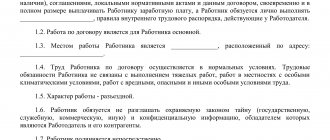Normative base
Resolution of the State Labor Committee of the USSR, the Secretariat of the All-Union Central Council of Trade Unions, the Ministry of Health of the USSR dated December 31, 1987 N 794/33-82 “On approval of the Basic Provisions on the shift method of organizing work”
Decree of the Government of the Russian Federation dated 02/03/2005 N 51 “On the amount and procedure for paying bonuses for shift work employees of federal government bodies and federal government agencies"
Letter of the Ministry of Finance of Russia dated 02/09/2018 N 03-04-05/7999
Federal Law of July 24, 1998 N 125-FZ “On compulsory social insurance against industrial accidents and occupational diseases”
Decree of the Government of the Russian Federation of July 18, 1996 N 841 “On the List of types of wages and other income from which alimony for minor children is withheld”
Federal Law of October 2, 2007 N 229-FZ “On Enforcement Proceedings”
The specifics of working on a shift basis are established by Chapter 47 of the Labor Code of the Russian Federation. Also today, to the extent that does not contradict the provisions of the Labor Code, the working conditions of such workers are regulated by Decree of the USSR State Committee for Labor, the Secretariat of the All-Union Central Council of Trade Unions, and the USSR Ministry of Health dated December 31, 1987 No. 794/33-82.
Calculation of allowance
If the employee has a monthly salary, then the bonus for the rotation method can be calculated using the formula:
| Shift work allowance | = | Employee salary | : | Number of calendar days of the month | × | Number of days the employee is on shift (on the road) | × | % premium |
If an employee has an hourly rate, the bonus can be calculated using the formula:
| Shift work allowance | = | Hourly rate | × | Number of working hours per month according to the calendar | : | Number of calendar days of the month | × | Number of days the employee is on shift (on the road) | × | % premium |
In its local documents, an organization may provide for any other procedure for paying bonuses. For example, you can set a fixed amount of bonus (like a daily allowance) for each day you are on shift.
Such rules are provided for in paragraph 5.6 of Appendix 1 to the resolution of the State Committee for Labor of the USSR, the Secretariat of the All-Union Central Council of Trade Unions, the Ministry of Health of the USSR dated December 31, 1987 No. 794/33-82 and part 4 of Article 302 of the Labor Code of the Russian Federation.
An example of calculating the salary of an employee working on a rotational basis
Employee of Alpha LLC A.I. Ivanov works on a rotational basis (from the 1st to the 15th of each month, 10 hours a day). He is provided with a summarized recording of working hours. The accounting period is quarter.
Ivanov has an hourly rate of 100 rubles/hour. According to the collective agreement, for the days he is on shift and on the way to his place of work, he is awarded a bonus in the amount of 30 percent of the monthly rate. The monthly rate is calculated based on the number of working hours according to the production calendar (based on a 40-hour work week). The daily rate is calculated based on normal working hours for a 40-hour work week (eight hours per day).
In July, Ivanov worked 15 days. On June 29–30 and July 16–17, he was en route to his place of work (and back).
For July, Ivanov was accrued:
- salary for hours worked, calculated based on the hourly rate;
- allowance for shift work;
- daily rate accrued for days in transit to the place of work.
The employee’s salary for the time worked was: 100 rubles/hour × 10 hours/day. × 15 days = 15,000 rub.
According to the production calendar, the average monthly number of working hours per year is 164.17 (based on a 40-hour work week). When calculating the bonus, the accountant took into account that in July 2014 the employee was on the road for two days. The bonus for the rotation method is equal to: 100 rubles/hour × 164.17 hours: 31 days. × (15 days + 2 days) × 30% = 2700.86 rub.
Payment for days in transit to the place of work will be: 100 rubles/hour × 8 hours/day. × 2 days = 1600 rub.
In total for July the employee was accrued: 15,000 rubles. + 2700.86 rub. + 1600 rub. = 19,300.86 rub.
Situation: is it possible not to set a bonus for shift work, but to give the shift worker an increased salary?
Answer: no, you can't.
In this case, the organization will violate labor laws. The bonus is paid:
- for each calendar day of the employee’s stay at the place of work during the shift period;
- for the days when the employee was on the way from the organization’s location (collection point) to the place of work and back.
This is stated in Article 302 of the Labor Code of the Russian Federation.
That is, allowances must be accrued for each day the employee stays in the above conditions. If you simply set an employee’s salary at an increased rate, this feature will not be taken into account. Regardless of the length of duty, the employee will receive the same amount every month.
If an employee works in the Far North or equivalent areas, a regional coefficient and percentage bonuses are established for his salary (like all other employees working in the northern regions).
Payroll calculation for shift work
The work schedule in question involves the performance of work duties in a place significantly removed from the employees’ place of residence and the location of the company itself. With such a schedule, daily return to the place of residence of workers is impossible or economically and technologically inappropriate.
Due to the specifics of such a schedule, the internal labor regulations of enterprises introduce summarized recording of working time. The accounting period can be from one month to a year. It includes:
- work time;
- inter-shift rest time;
- travel time from the employer’s location to the place where work duties are performed.
The duration of working hours in the accounting period should not exceed the normal number of working hours according to the production calendar.
To calculate wages, both a time-based system (based on tariff rates and salaries) and a piece-rate system can be used. The employer can also provide in local regulations the procedure for paying bonuses and incentive bonuses.
In addition to working time, based on the daily tariff rate or part of the salary per day of work, the following are paid:
- every day of inter-shift rest;
- every day the employee is en route to the place of performance of work duties, as well as days of delay in transit due to weather conditions or other valid reasons.
Such days are paid without the use of regional coefficients and allowances for a specific work schedule.
How should employers determine the amount of shift pay?
The Ministry of Labor explained how employers should determine the amount and procedure for paying bonuses for shift work (letter dated August 19, 2019 No. 14-1/OOG-5862).
The agency reminds that the rotation method is a special form of carrying out the labor process outside the place of permanent residence of workers, when their daily return to their place of permanent residence cannot be ensured. This is determined by the norms of Article 297 of the Labor Code of the Russian Federation.
At the same time, Article 302 of the Labor Code of the Russian Federation prescribes that persons performing work on a rotational basis, instead of daily allowance, should be paid a special allowance for each calendar day of stay in places of work during the shift period, as well as for the actual days of travel from the location of the employer (collection point) to the place completing the work and back.
The amount and procedure for paying the bonus for shift work depend on the organization in which the employee is employed.
For employees of federal government bodies and federal government institutions, the amount and procedure for paying bonuses for shift work are established by Decree of the Government of the Russian Federation dated February 3, 2005 No. 51.
For employees of regional government agencies and government agencies, local government bodies and municipal institutions, the amount and procedure for payment of bonuses for rotational work are established by regional or local regulatory legal acts.
For other employers, the amount and procedure for paying bonuses for shift work are established by a collective agreement, an employment contract and local regulations adopted taking into account the opinion of the trade union.
BUKHPROSVET
A shift is considered to be a total period, including the time of work performed at the site and the time of rest between shifts. The duration of the shift should not exceed one month. In exceptional cases, the duration of the shift can be increased by the employer to 3 months (Article 299 of the Labor Code of the Russian Federation).
When working on a rotational basis, a summarized accounting of working time is established for a month, quarter or six months, but not more than for one year. The accounting period covers all working time, travel time from the employer’s location or from the collection point to the place of work and back, as well as rest time.
Work performed on a rotational basis cannot involve workers under the age of 18, pregnant women and women with children under 3 years of age, as well as persons who have contraindications to performing work on a rotational basis in accordance with a medical report.
Workers who travel to perform work on a rotational basis in the regions of the Far North are set a regional coefficient and are paid a percentage increase in wages. In addition, they are provided with additional paid leave of 24 calendar days. Employees working in areas equated to the regions of the Far North are also provided with additional leave of at least 16 calendar days (Article 321 of the Labor Code of the Russian Federation).
Shift allowance in 2021
A shift bonus is an additional payment that is established for employees with such a work schedule instead of daily allowance. What legislative document establishes the amount of the shift allowance?
For employees of government institutions, their size is established by the government body at the appropriate level of government. Thus, for federal government bodies, an allowance for shift work has been approved by Decree of the Government of the Russian Federation dated 02/03/2005 No. 51 and is based on the salary or tariff rate:
- 75% - in the Far North;
- 50% - in the regions of Siberia and the Far East;
- 30% - in other areas.
Commercial enterprises establish surcharges by local regulations (orders, regulations) or are prescribed in a collective agreement.
The bonus is paid for each day of stay at the place of performance of work duties, as well as for each day of travel to it from the collection point.
Shift payments and their taxation
Shift workers, in addition to wages, are entitled to additional payments for more intensive work and forced living outside the home 2:
- bonus for shift work instead of daily allowance;
- payment for days of travel from the location of the employer (collection point) to the place where work is performed and back, as well as days of delay in travel due to meteorological conditions or due to the fault of transport organizations;
- payment for days of inter-shift rest due to overtime within the work schedule of the shift.
Note.
For shift workers who work in the Far North and equivalent areas, their salaries (excluding additional payments) increase by the regional coefficient. They are also paid northern percentage bonuses for length of service 3. An allowance in lieu of daily allowance, payment for inter-shift rest days and travel days are taken into account in “profitable” expenses as labor costs 4.
Payments to employees for inter-shift rest days are subject to all “salary taxes” 5. But the allowance in lieu of daily allowance and payments for days on the road reimburse employees’ expenses for performing work duties outside the home 6. Therefore, they are not taxed as compensation payments:
- Personal income tax 7;
- insurance premiums, including contributions for injuries 8.
Shift allowance: taxation 2021 and other deductions
Tax legislation does not establish rules for taxation of the surcharge in question. But most recently, in Letter No. 03-04-05/7999 dated 02/09/2018, the Russian Ministry of Finance confirmed its position that this payment is compensatory and therefore not subject to taxation:
- personal income tax (paragraph 11, clause 3, article 217 of the Tax Code of the Russian Federation);
- insurance premiums (paragraph 10, paragraph 2, paragraph 1, article 422 of the Tax Code of the Russian Federation).
The payment in question is subject to contributions for compulsory insurance against accidents at work, since it is not named in Article 20.2 of Federal Law 125 of July 24, 1998, which establishes a list of payments that are not subject to contribution.
Calculation of alimony during shift work also has its own peculiarity. Thus, the bonus paid is not included in the basis for calculating withholding. Otherwise, alimony is calculated in the standard manner in accordance with Government Decree No. 841 of July 18, 1996 and Article 101 of Federal Law No. 229 of October 2, 2007.
When is the premium paid?
Payments to workers employed on a rotational basis are made in three cases:
- When they are directly at the place of work.
- When they move from the collection point for shift personnel directly to the place where the work will be carried out.
- When they come back.
Please note: the premium is paid for calendar days, not working days. Therefore, even if the work was not actually carried out, the employee still has the right to receive money.
People from different cities and even regions can be busy on shifts, so the road itself is divided into two parts - from the employee’s home to the assembly point and from the point to the workplace. In Soviet times, there was a rule according to which the shift worker was paid for the entire journey. Now the employer is obliged to pay money only for the second part of the journey. However, there is no prohibition on reimbursement of expenses, and an employer who has the financial capacity can also pay for travel from home. However, the rules on allowance for shifts will not apply to these payments. In particular, they may be subject to mandatory insurance contributions and personal income tax.
Since the bonus is not a payment, regional coefficients cannot be calculated on it (for example, for work in the Far North). However, “northern” ones are calculated on the basic salary of a shift worker. It’s just that in this particular case, the employee will separately receive compensation for work on shift, and separately, an increased salary, due to a special coefficient.








